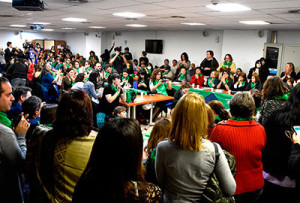By Victoria Pedrido
On March 20, five draft bills to pass the Voluntary Pregnancy Termination law were debated by Commissions in Parliament. Of those, one that was forwarded by the National Campaign for the Right to Legal, Safe and Free Abortion has the signatures of 71 legislators from different party blocks. The bill is expected to reach the House Plenary in June 2018.
Without question, the conquests and advances in the field of sexual and reproductive rights are the product of resilient activism carried out by women’s movements, and the movements of feminisms and sexual dissidence. In Argentina, we, women from different political, social, national and ethnic backgrounds have set abortion within the human rights framework and in the public health agenda. Through the promotion of collective spaces of reflection in women’s meetings, in universities, neighbourhoods, and grassroots communities, among a myriad of other different places, we set out to communicate, theorize, bring together as many voices as possible, and build networks.
In the timeline of this struggle, the National Campaign for the Right to Legal, Safe and Free Abortion was founded in 2005. “Sexuality education in order to decide, contraceptives so as to not abort, legal abortion so as to not die” is the Campaign slogan and is an echo that resonates and multiplies in every rally, in the voices that demand the right to abortion in sanitary conditions and with dignity and equality.

The State is responsible for abortion being illegal. Since 1921 the Argentinian Penal Code establishes that abortion is allowed when the pregnancy is the result of rape and when the woman’s life or health is at risk. Despite this almost century-old ruling, this norm has been systematically badly implemented, “unknown” and denied. After a course of countless unnecessary judicial cases and sanctions promoted by the Argentinian State for breaching its responsibility as guarantor of a legally consecrated right, the Supreme Court issued an opinion in 2010, known as the “FAL ruling”, which judged the prosecution of cases of non-punishable abortions as unnecessary and illegal. During the ruling, the Supreme Court exhaustively clarified all doubts on the interpretation of the norm that enables legal abortions to date in Argentina and urged the national and provincial ministries to implement the appropriate protocols for dealing with pregnancy terminations (or non-punishable abortions) following international health standards. Despite the almost hundred-year-old law and the court ruling, the regulation is disrespected or, in the best-case scenario, its application is left to the discretion of the health institution, the health professional and/or the conscientious objector on duty.
It is not the same. Abortion is a health issue and not a medical one even though it requires a medical intervention. But what is the difference? The distinction lies in the fact that health is not exhausted by being opposite to disease nor by the physician’s interpretation of how a person who does not want to carry on with a pregnancy for multiple reasons, lives, thinks and feels. Health is not limited to the biomedical spectrum but rather involves social, physical and emotional aspects. To want to and to be able to, are not the same in the case of abortion.
To have an abortion based on the physician on duty’s opinion about a risk to your health, or our health, is not the same as voluntarily choosing to have an abortion. It is not the same to have a clandestine abortion and to have conditions of safety varying according to one’s financial power, as it is to have the procedure at a health facility at a hospital or in your house with the proper medication, with the company you wish to have by your side, and then be advised on the possibility of future contraceptive methods to choose from.
Deciding for oneself is not the same as having to ask or beg to be allowed a practice that, in terms of sexual health, is as valid as any other is, and that therefore should be guaranteed with adequate respect and attention by the State through the Health System. It is not the same to have abortion linked to the health of the person who seeks the procedure as it is to link it to their death.
The organizations and activists in the National Campaign for the Right to Legal, Safe and Free Abortion know this and forwarded the first draft bill to legalize abortion in 2007. Then they forwarded the bill again in 2008, 2010, 2012, 2014 and in 2016.
Where the debate currently stands. On February 9, the Campaign convoked a pañuelazo, a rally – in which activists wore green handkerchiefs, a symbol of the Campaign for the right to decide – that spread across the country. We took over the streets. On March 6, the Campaign forwarded for the seventh time the draft bill on Voluntary Termination of Pregnancy, supported by 71 legislators of diverse parties. On March 20, the formal processing of the abortion legalization bill began in the Congress. Five draft bills were under scrutiny, of which the main bill was the one forwarded by the Campaign. That same evening at 6:30 pm, there was a Commission plenary where the work methodology was decided for holding future meetings and public hearings in the coming months. Abortion will be discussed in the Special Commissions on Social Action and Public Health; Family, Women, Adolescents and Children; and, Criminal Law and General Law. The Campaign’s bill proposes the decriminalization and legalization of abortion until the fourteenth week of pregnancy, and beyond that date when the women’s health or life is at risk, in cases of rape and serious fetal malformations. It proposes that service provision extends to three health subsystems: public, private and obra social (health coverage provided through workers’ unions). The opposing voices will advocate for non-punishment in exceptional cases, something that has already been regulated for many years and, as previously stated, is not followed through with total impunity. Other tepid positions will incline to decriminalization but not legalization. We hope the bill reaches the House Plenary before June 2018. But for now, and it is no small victory, the debate has flooded the streets and entered Parliament.



